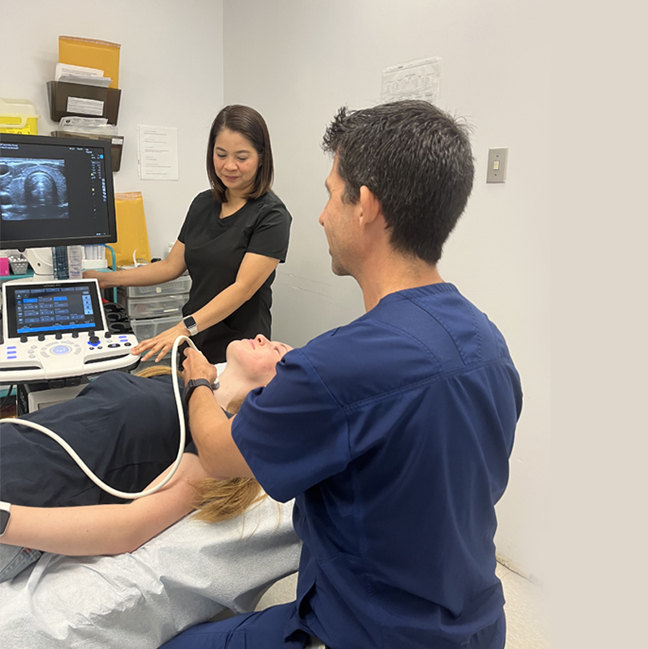Thyroid Nodules

A thyroid nodule is an abnormal growth or lump that forms within the thyroid gland, which is located in the front of the neck. It is a discrete, solid or fluid-filled structure that can vary in size and may be palpable or visible as a lump on the neck.
Thyroid nodules can be caused by various factors, including overgrowth of thyroid tissue, cysts, or the formation of solid masses. While most thyroid nodules are benign (non-cancerous), some can be malignant (cancerous). It is essential to have any thyroid nodule evaluated by a healthcare professional to determine its nature and appropriate management.
Thyroid nodules often develop without causing noticeable symptoms. At times, they are discovered incidentally during routine physical exams or imaging tests, such as ultrasound or CT scans, performed for unrelated reasons. However, larger nodules or those causing compression of nearby structures may present symptoms such as a visible or palpable lump in the neck, difficulty swallowing or breathing, hoarseness, or occasional discomfort.
When a thyroid nodule is detected, further evaluation is typically recommended to assess its characteristics and determine the risk of malignancy. Diagnostic tests may include ultrasound imaging, ultrasound guided fine needle aspiration biopsy (USFNA), or other imaging modalities. USFNA involves using a thin needle to extract cells from the nodule for laboratory analysis, helping to establish a diagnosis and guide treatment decisions.
The majority of thyroid nodules are benign, with only a small percentage being malignant. According to some studies and medical literature, approximately 90-95% of thyroid nodules are non-cancerous or benign. This means that the likelihood of a thyroid nodule being benign is significantly higher than it being malignant.
Several factors can help determine the risk of malignancy in a thyroid nodule, including its size, shape, presence of calcifications, and the patient’s age and medical history. Nodules that exhibit suspicious features may require further investigation or surgical intervention to confirm whether they are cancerous.
Management
The management of thyroid nodules depends on various factors, including their size, characteristics, and the presence of concerning features. Treatment options may range from observation and periodic monitoring, surgical removal, or radioactive iodine therapy, depending on the specific circumstances and the presence of malignancy.
Prevalence of Malignancy
The prevalence of malignant thyroid nodules can vary based on several factors, including age, gender, and individual risk factors. It is important to note that the risk of malignancy can increase with certain factors. These include a family history of thyroid cancer, exposure to radiation, growth of the nodule, presence of suspicious features on ultrasound, and the presence of specific genetic mutations.
If a thyroid nodule is discovered, it is typically evaluated using ultrasound imaging and may undergo a fine needle aspiration biopsy (USFNA) to obtain a sample of cells for further analysis. The results of these tests, along with the individual’s clinical history and risk factors, will help determine the likelihood of malignancy.

It is important to consult with a health care professional who can evaluate your specific case and provide personalized guidance based on your medical history, physical examination, and diagnostic findings.
Remember that the majority of thyroid nodules are benign, but it is crucial to undergo proper evaluation and monitoring to ensure accurate diagnosis and appropriate management. It is important to consult with a healthcare professional, typically an otolaryngologist (ENT specialist), endocrinologist or endocrine surgeon, for proper evaluation, diagnosis, and individualized management of thyroid nodules.

